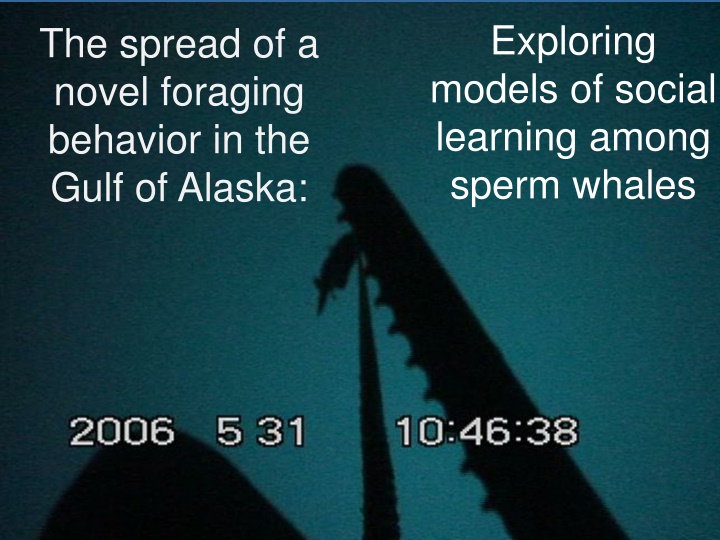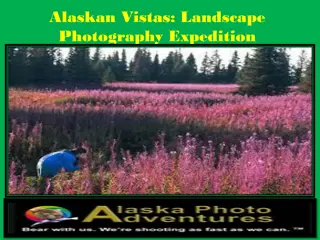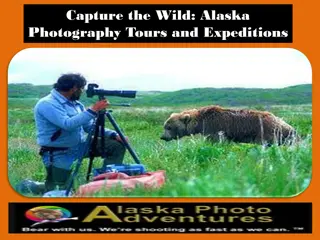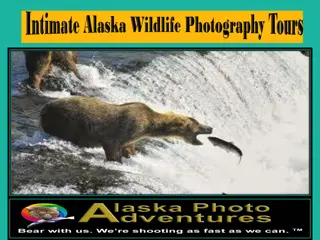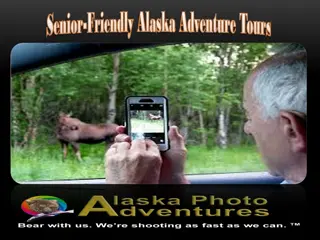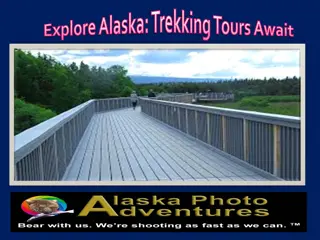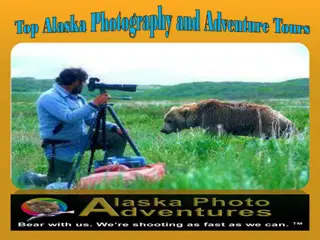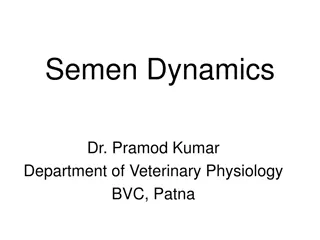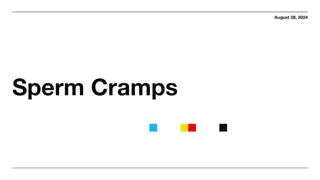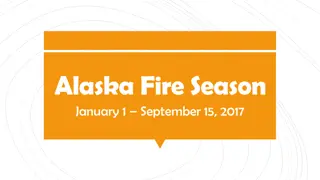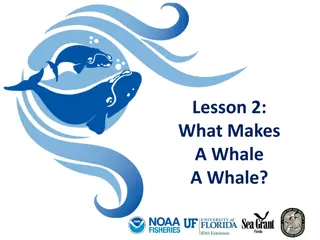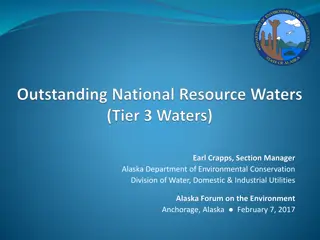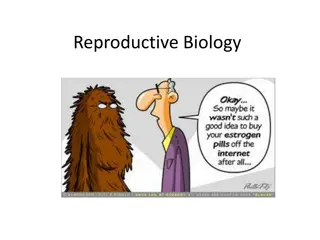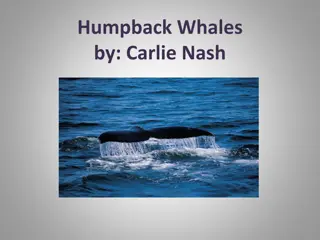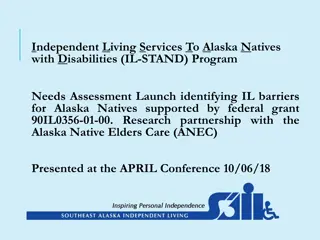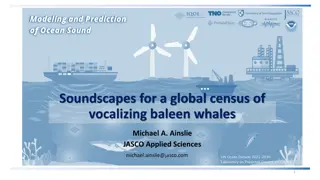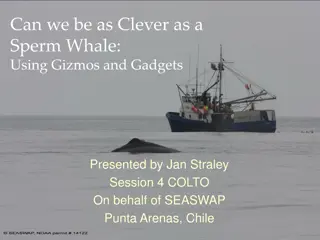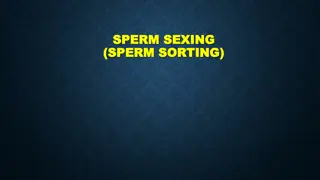Social Learning Among Sperm Whales and Sablefish in the Gulf of Alaska
Explore the spread of novel foraging behavior among sperm whales, depredation issues with sablefish, and the history of commercial fishing in the Gulf of Alaska. Discover insights into sperm whale sightings, the blackcod fishery, and the changing dynamics of sablefish commercial seasons.
Download Presentation

Please find below an Image/Link to download the presentation.
The content on the website is provided AS IS for your information and personal use only. It may not be sold, licensed, or shared on other websites without obtaining consent from the author.If you encounter any issues during the download, it is possible that the publisher has removed the file from their server.
You are allowed to download the files provided on this website for personal or commercial use, subject to the condition that they are used lawfully. All files are the property of their respective owners.
The content on the website is provided AS IS for your information and personal use only. It may not be sold, licensed, or shared on other websites without obtaining consent from the author.
E N D
Presentation Transcript
Exploring models of social learning among sperm whales The spread of a novel foraging behavior in the Gulf of Alaska:
COLOTO Depredation Workshop March 2016 presented to you by Jan Straley University of Alaska
US NOAA Federal Sablefish Survey annual sablefish assessment Up to ONE meter Sablefish are Big High in Oil High Value
Natural History Single species world wide (Physeter macrocephalus) Largest odontocete ( 18m) BIG Teeth (~50) bottom jaw only Geographically widespread Prey on deep sea squids & fishes Extreme divers (40 min / 2+ hrs) Highly sexually dimorphic Human life-spans Largest brain on earth Remarkably strong social bonds Photograph courtesy of Flip Nicklin
Sablefish Depredation on Commercial Fishing Vessels
Sperm Whale Sightings (1958-1995) Prey primarily squid Prey primarily deep water fishes NMML unpublished data, cited in Hill et al., 1999
Blackcod fishery began in the late 1800s 1958: longliners in the Bering Sea and internal waters 1960 s: longline fishery expands to the Gulf of AK 1982: begin Americanization most foreign effort gone Mid-1980 s: open-access season shortens, derby 1995: Individual Fishery Quota implemented (IFQ)
Length of Commercial Fishing Season for Sablefish in the Gulf of Alaska1983 to present Year-round 2 week 9 month 14 Season Length (months) 12 10 IFQs Individual Fishing Quotas 8 6 4 2 0 1995 1983 1984 1985 1986 1987 1988 1989 1990 1991 1992 1993 1994 1996 1997 1998 1999 2000 2001 2002 Year 1983 Current season length
Blackcod longline operations use vertical anchorlines Ground line 2-3 miles 3000-5000 hooks
Sablefish Sablefish lucrative fishery in the Gulf of Alaska Over 500 permit holders Price $3-$6 US per pound
US NOAA Federal Sablefish Survey NMFS longline sablefish assessment surveys in GOA F/V Alaskan Leader Fish same stations/year F/V Ocean Prowler Record the behavior of sperm whales around fishing operations Photo-identify sperm whales Photo: upper Capt. Dennis Black; lower SEASWAP
Human-Wildlife Conflict fishing, farming and ranching sperm whale, killer whale depredation of longlines; humpbacks salmon fry and smotls scientific, management, and conservation issue socio-economic, how to incorporate into predictive models bycatch mortality from ingestion/entanglement ?? potential for retaliatory actions by fisherman ?? Not documnted
-15900' -156 00' -153 00' -150 00' -147 00' -144 00' -141 00' 60 00' 136 60 00' ## 137 # 91 # 93 90 134 92 # # # 135 # # 87 89 132 # # 88 # 133 131 # ## # 86 130 # 85 129 # # # 84 128 57 00' # 83 # 127 82 # # 126 57 00' # 81 125 # # 124 80 # 122 # 79 # # 123 77 # # 78 121 # # # 120 76 # 75 -156 00' -153 00' -150 00' -147 00' -144 00' social transmission or independent among multiple individuals (individual learning)? #74
Diffusion Curve Analysis (DCA) temporal spread of a new behavior through a population Number of whales involved in depredation Social learning Time Can not be used alone to describe social learning Can be used with other methods such as Wave of Advance Rogers 1995, Cavalli Sforza and Feldman 1981, Heinrich 2001, Reeder 2004
Wave of Advance Track through time Locus of innovation Spatial radiation Otherwise pop up randomly Europe - Used to document the spread agriculture in Europe during the Neolithic Ammerman and Cavalli-Sforza (1984)
US NOAA Federal Sablefish Survey standardized, fishery-independent survey Sample sablefish habitat overlap/ commercial fishing grounds -159 00' -156 00' -153 00' -150 00' -147 00' -144 00' -141 00' 60 00' 136 60 00' ## 137 # 91 # 93 90 134 92 # # # 135 # # 87 89 132 # # 88 # 133 131 # ## # 86 130 # 85 129 # # # 84 128 57 00' # 83 # 127 82 # # 126 57 00' # 81 125 # # 124 80 # 122 # 79 # # 123 77 # # 78 121 # # # 120 76 # 75 -156 00' -153 00' -150 00' -147 00' -144 00' DCA Diffusion Curve Analysis x=survey year and predation presence / number of whales y=cumulative number of stations
Diffusion Curve Analysis Depredation N=126 stations Cumulative stations with whales 1998 2010 Whales at station ranged 1-7 (mean of 3) Linear model was the best AAIC fit
Results: Wave of Advance 1999-2004
Both models provide evidence for social transmission Limitations: population-level, lack of innovation data, what whales are doing Learning mechanisms (imitation, emulation, observational conditioning)
Acknowledgements Zach Shackner NOAA for the years of data CSUF Evolutionary Anthropology Department Master s committee; John Bock, Peter Fashing, Sarah Mesnick, and John Patton The authors would like to thank Keith Garner for GIS advice and the Blumstein Lab for comments. Background Photos courtesy of Southeast Alaska Sperm Whale Avoidance Project (SEASWAP). SEASWAP cooperative study fishermen, scientists and government managers formed to find ways to mitigate the impacts of depredation. www.seaswap.info/
